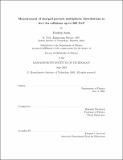| dc.contributor.advisor | Boleslaw Wyslouch. | en_US |
| dc.contributor.author | Sarin, Pradeep, 1975- | en_US |
| dc.contributor.other | Massachusetts Institute of Technology. Dept. of Physics. | en_US |
| dc.date.accessioned | 2005-05-19T15:20:38Z | |
| dc.date.available | 2005-05-19T15:20:38Z | |
| dc.date.copyright | 2003 | en_US |
| dc.date.issued | 2003 | en_US |
| dc.identifier.uri | http://hdl.handle.net/1721.1/16933 | |
| dc.description | Thesis (Ph. D.)--Massachusetts Institute of Technology, Dept. of Physics, 2003. | en_US |
| dc.description | Vita. | en_US |
| dc.description | Includes bibliographical references (p. 155-165). | en_US |
| dc.description | This electronic version was submitted by the student author. The certified thesis is available in the Institute Archives and Special Collections. | en_US |
| dc.description.abstract | Au+Au collisions in the Relativistic Heavy Ion Collider (RHIC) herald a new era of opportunities for studying hadronic matter under conditions of high energy density and nucleon density. The theory of strong interactions, Quantum Chromodynamics (QCD), tells us very little about the dynamics of a strongly interacting many-body system in this non-perturbative regime. Therefore, characterizing the collisions using global extrinsic observables becomes important. The distribution of charged particles produced in an ultra-relativistic heavy ion collision, being proportional to the initial energy density in the collision volume, is one such global observable. An anomalous change in particle multiplicity from lower energy collisions and/or peripheral to central collisions could indicate the onset of non-perturbative effects like deconfinement of quarks and gluons, or non-linear dynamics such as parton saturation. We determine the pseudo-rapidity distribution of charged particles from hits recorded in pixels of the PHOBOS silicon multiplicity detector, after applying corrections for detector acceptance, occupancy and background particles. The collision centrality is estimated by measuring the energy deposited in scintillator trigger detectors and comparing it to Monte Carlo simulations for events with different impact parameters. We find the total number of charged particles produced in central Au+Au collisions at [the square root of] sNN = 130 GeV and [the square root of] sNN = 200 GeV to be 4160+/-210 and 5050+/-250 respectively. The pseudo-rapidity distributions of charged particles show two remarkable features. In the fragmentation region, the distribution follows a limiting curve independent of the collision energy, similar to the limiting fragmentation behaviour seen earlier in p + p and p + A collisions. | en_US |
| dc.description.abstract | (cont.) In the mid-rapidity region, the yield of charged particles evolves smoothly as a function of [the square root of] sNN and collision centrality. We compare our results with a compilation of data from lower energy p + p, p + A and A + A collisions and discuss their implications for various phenomenological models of particle production. | en_US |
| dc.description.statementofresponsibility | by Pradeep Sarin. | en_US |
| dc.format.extent | 173, 4 p. | en_US |
| dc.format.extent | 5133938 bytes | |
| dc.format.extent | 24619446 bytes | |
| dc.format.mimetype | application/pdf | |
| dc.format.mimetype | application/pdf | |
| dc.language.iso | eng | en_US |
| dc.publisher | Massachusetts Institute of Technology | en_US |
| dc.rights | M.I.T. theses are protected by copyright. They may be viewed from this source for any purpose, but reproduction or distribution in any format is prohibited without written permission. See provided URL for inquiries about permission. | en_US |
| dc.rights.uri | http://dspace.mit.edu/handle/1721.1/7582 | |
| dc.subject | Physics. | en_US |
| dc.title | Measurement of charged particle multiplicity distribution in Au + Au collisions up to 200 GeV | en_US |
| dc.type | Thesis | en_US |
| dc.description.degree | Ph.D. | en_US |
| dc.contributor.department | Massachusetts Institute of Technology. Department of Physics | |
| dc.identifier.oclc | 53103199 | en_US |
